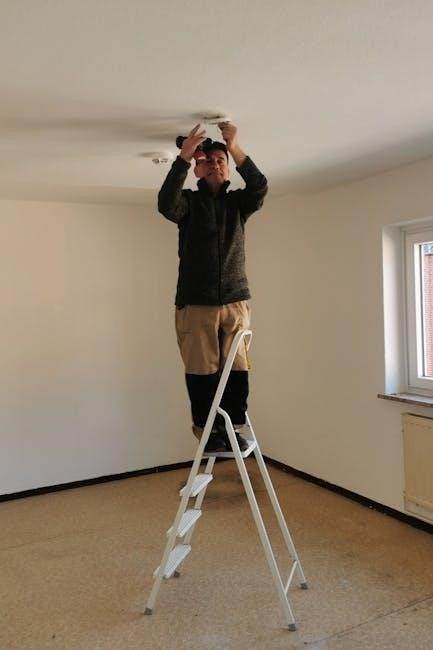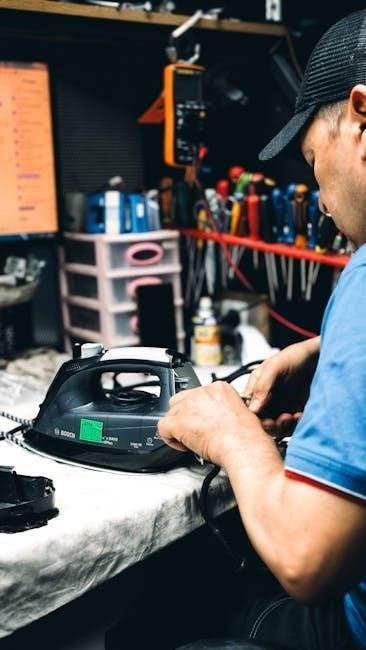The 2016 Honda CR-V maintenance schedule ensures optimal performance and longevity through regular servicing‚ including oil changes‚ tire rotations‚ and inspections‚ tailored to specific mileage intervals.
1.1 Importance of Regular Maintenance
Regular maintenance is crucial for extending the lifespan of your 2016 Honda CR-V. It ensures optimal performance‚ prevents mechanical failures‚ and maintains fuel efficiency. Neglecting scheduled services can lead to costly repairs and safety risks. By following the recommended maintenance schedule‚ you protect your investment‚ reduce wear and tear‚ and ensure reliability. Regular checks also help identify potential issues early‚ avoiding breakdowns. Proper upkeep preserves the vehicle’s value and enhances overall driving safety. Stay proactive with routine maintenance to keep your CR-V running smoothly for years.
1.2 Overview of the 2016 Honda CR-V
The 2016 Honda CR-V is a compact SUV known for its reliability and versatility. It features a 1.8L or 2.4L engine‚ offering a balance of power and fuel efficiency. With a spacious interior‚ it caters to both commuters and families. The CR-V also boasts advanced safety features and a smooth ride‚ making it a popular choice. Its robust design and efficient performance require consistent maintenance to uphold its quality and ensure long-term durability. Proper care‚ as outlined in the maintenance schedule‚ is essential to maintaining its optimal functionality and overall value.

Scheduled Maintenance Intervals
Scheduled maintenance intervals for the 2016 Honda CR-V occur at 15‚000‚ 30‚000‚ 45‚000‚ and 60‚000 miles‚ ensuring optimal performance‚ preventing issues‚ and maintaining vehicle health.
2.1 Every 15‚000 Miles
At every 15‚000 miles‚ the 2016 Honda CR-V requires essential maintenance‚ including an oil and filter change‚ tire rotation‚ and a comprehensive vehicle inspection. This interval ensures optimal performance and helps identify potential issues early. Additionally‚ the oil drain plug and gasket are replaced to prevent leaks. Wiper blades are inspected and replaced if necessary‚ and the tire pressure is checked and adjusted. This routine service is crucial for maintaining the vehicle’s reliability and extending its lifespan. Regular inspections at this interval help prevent costly repairs and ensure all systems are functioning as intended.
2.2 Every 30‚000 Miles
At 30‚000 miles‚ the 2016 Honda CR-V requires more detailed maintenance‚ including replacing the engine air filter and inspecting the belts for wear. Spark plugs are checked and replaced if necessary‚ and the exhaust system is inspected for leaks or damage. Additionally‚ the front and rear brakes are serviced‚ and the suspension components are checked for stability. This interval also includes lubrication of key components and a thorough inspection of the vehicle’s systems to ensure everything functions smoothly. Regular attention at this stage helps maintain performance and prevents potential issues from escalating.
2.3 Every 45‚000 Miles
At 45‚000 miles‚ the 2016 Honda CR-V requires more extensive maintenance to maintain optimal performance. This includes replacing the engine air filter and checking the belts for wear. The exhaust system is inspected for leaks or damage‚ and spark plugs are replaced if necessary. Additionally‚ the front and rear brakes are serviced‚ and the suspension components are checked for stability. This interval also includes lubrication of key components and a thorough inspection of the vehicle’s systems to ensure everything functions smoothly. Regular attention at this stage helps maintain performance and prevent potential issues from escalating.
2.4 Every 60‚000 Miles
At 60‚000 miles‚ the 2016 Honda CR-V requires a more detailed service. This includes inspecting and potentially replacing the timing belt and accessory belts to prevent failure. Brake fluid is typically replaced to maintain braking performance. The transmission fluid may also be changed to ensure smooth gear operation. Spark plugs are replaced at this interval to maintain proper engine combustion. Additionally‚ the vehicle undergoes a thorough inspection‚ including the suspension‚ steering‚ and exhaust system‚ to identify any potential issues early. This comprehensive service ensures the CR-V continues to run efficiently and reliably.

Common Maintenance Tasks
Regular maintenance tasks for the 2016 Honda CR-V include oil changes‚ tire rotations‚ and inspections to ensure optimal performance and extended vehicle lifespan.
3.1 Oil Change and Filter Replacement

Regular oil changes are essential for the 2016 Honda CR-V. Synthetic oil is recommended for optimal performance. Replace the oil filter during each service to ensure clean oil circulation. Honda suggests changing the oil every 5‚000 to 7‚500 miles‚ depending on driving conditions. Proper lubrication prevents engine wear and maintains fuel efficiency. Always use the correct viscosity grade specified in the owner’s manual. Neglecting oil changes can lead to engine damage and costly repairs. Use a Honda-approved filter for reliability and performance. Check the maintenance minder for accurate oil change intervals tailored to your driving habits.
3.2 Tire Rotation and Pressure Check
Tire rotation and pressure checks are crucial for extending the life of your 2016 Honda CR-V’s tires. Rotate tires every 5‚000 to 8‚000 miles to ensure even tread wear. Proper tire pressure‚ as specified in the owner’s manual‚ improves fuel efficiency and handling. Underinflated tires can lead to uneven wear and reduced performance. Check tire pressure monthly and before long trips. Regular rotations prevent uneven wear patterns and maintain traction. Neglecting these tasks can compromise safety and lead to premature tire replacement. Always refer to the maintenance schedule for precise intervals and recommendations.
3.3 Brake Inspection and Pad Replacement
Regular brake inspections are essential for ensuring the safety and reliability of your 2016 Honda CR-V. Inspect brake pads every 15‚000 miles and replace them when worn down to 1/8 inch or less. Brake rotors should also be checked for excessive wear or warping. Proper brake maintenance prevents costly repairs and ensures consistent stopping performance. The maintenance schedule recommends replacing brake pads every 30‚000 to 50‚000 miles‚ depending on driving conditions. Always use genuine Honda parts for optimal reliability and safety. Neglecting brake maintenance can lead to reduced braking efficiency and increased risk of accidents. Stay proactive to protect your vehicle and passengers.

Parts Requiring Regular Replacement
Key components like air filters‚ spark plugs‚ and timing belts need regular checks and replacement to maintain performance and prevent damage. Follow the schedule for optimal longevity.
4.1 Air Filter Replacement
The air filter in your 2016 Honda CR-V should be replaced every 15‚000 to 30‚000 miles‚ depending on driving conditions. A clean air filter ensures proper engine performance‚ fuel efficiency‚ and reduces emissions. Dusty or clogged filters can lead to decreased horsepower and poor gas mileage. The maintenance schedule recommends inspecting and replacing the air filter as needed‚ especially in polluted or dusty environments. Regular replacement helps maintain optimal airflow to the engine‚ preventing potential damage and ensuring your vehicle runs smoothly. Always refer to the PDF guide for specific instructions and recommendations tailored to your vehicle’s needs.
4.2 Spark Plug Replacement
Spark plugs in the 2016 Honda CR-V should be replaced every 45‚000 miles to ensure proper engine ignition and performance. Worn-out spark plugs can cause misfires‚ reduced fuel efficiency‚ and rough engine operation. The maintenance schedule recommends inspecting plugs for wear and replacing them as needed. Proper installation and gapping are crucial to avoid engine damage. Refer to the PDF guide for detailed instructions and torque specifications. Regular spark plug replacement ensures optimal combustion‚ smoother engine operation‚ and prevents costly repairs down the road. Always use genuine Honda parts for reliability and performance.
4.3 Timing Belt and Accessory Belt Inspection
The timing belt and accessory belts in the 2016 Honda CR-V require regular inspection to prevent engine damage. The timing belt typically needs replacement at 105‚000 miles‚ while accessory belts should be checked every 15‚000 miles. Cracks‚ fraying‚ or misalignment are signs of wear. Neglecting belt replacements can lead to costly repairs‚ such as engine failure. The maintenance schedule recommends using genuine Honda parts for replacements. Inspecting belts ensures smooth engine operation and prevents unexpected breakdowns. Always refer to the PDF guide for detailed inspection and replacement procedures to maintain your vehicle’s reliability and performance.

Additional Maintenance Tips
Regularly check and maintain wiper blades‚ battery terminals‚ and fluid levels. Ensure proper tire pressure and inspect belts for wear. Clean air filters and keep the vehicle rust-free for optimal performance and longevity. Adhere to the recommended schedule to avoid overlooking critical services and maintain your CR-V’s reliability and efficiency. Always use genuine Honda parts for replacements to ensure compatibility and durability. Keep your vehicle clean and protected from environmental elements to preserve its condition. Following these tips will help extend the life of your Honda CR-V and prevent unexpected issues down the road. Stay proactive with routine checks to maintain peak performance and safety on the road. By prioritizing these additional maintenance tips‚ you can enjoy a smoother and more reliable driving experience for years to come. Regular maintenance not only saves money but also enhances overall vehicle health‚ ensuring your CR-V continues to run like new. Remember‚ consistent care is key to maximizing your vehicle’s longevity and performance capabilities. Always refer to your maintenance schedule for specific guidelines tailored to your 2016 Honda CR-V.
5.1 Wiper Blade Replacement
Regular wiper blade replacement is essential for clear visibility and safety. Replace blades every 6 to 12 months or when showing signs of wear‚ such as streaking or splitting. Ensure proper fit and functionality by using genuine Honda parts. Clean blades regularly with a soft cloth and mild detergent to maintain effectiveness. Inspect the wiper arms for damage or corrosion and lubricate if necessary; Properly installed wiper blades prevent water spots and improve driving visibility during rain or snow. Refer to your 2016 Honda CR-V maintenance schedule for specific recommendations and guidelines.
5.2 Battery Maintenance
Proper battery maintenance ensures reliable starting and electrical system performance. Check terminals for corrosion and clean them with a wire brush if necessary. Ensure all connections are tight and secure. Avoid deep discharging the battery‚ as it can reduce lifespan. Inspect the battery case for cracks or damage. Test the battery voltage regularly‚ especially in extreme temperatures. Replace the battery every 5-7 years or when showing signs of weakness. Use genuine Honda parts for replacements to maintain optimal performance. Refer to your 2016 Honda CR-V maintenance schedule for specific intervals and guidelines to keep your battery in excellent condition.

Importance of Adhering to the Schedule
Adhering to the schedule prevents costly repairs‚ ensures optimal performance‚ and prolongs vehicle lifespan by addressing issues before they escalate‚ keeping your CR-V running smoothly and efficiently.
6.1 Preventing Costly Repairs
Regular maintenance prevents costly repairs by identifying potential issues early. Neglecting tasks like oil changes or belt inspections can lead to major damage‚ such as engine failure. Staying on schedule ensures critical components like the timing belt and spark plugs are replaced before they cause expensive problems. This proactive approach saves money and extends the vehicle’s lifespan‚ avoiding unexpected breakdowns and ensuring long-term reliability. By addressing wear and tear promptly‚ you protect your investment and maintain your CR-V’s performance and safety on the road.
6.2 Ensuring Vehicle Performance
Regular maintenance ensures your 2016 Honda CR-V performs at its best. Tasks like oil changes‚ tire rotations‚ and inspections keep the engine running smoothly‚ optimizing fuel efficiency and power. Properly maintained vehicles handle better‚ accelerate more responsively‚ and maintain consistent performance. Neglecting scheduled maintenance can lead to decreased efficiency‚ reduced power‚ and potential issues with handling. By following the recommended schedule‚ you ensure all systems operate as designed‚ preserving your CR-V’s performance‚ reliability‚ and overall driving experience for years to come.

Signs Your Vehicle Needs Maintenance
Dashboard warning lights‚ unusual noises‚ or vibrations indicate your 2016 Honda CR-V needs attention. Addressing these signs promptly ensures issues are resolved before they escalate.
7.1 Dashboard Warning Lights
Dash warning lights signal maintenance needs‚ such as oil changes‚ tire pressure checks‚ or system malfunctions. The Maintenance Minder system alerts you when services like oil changes or tire rotations are due‚ ensuring timely attention to prevent issues.
7.2 Unusual Noises or Vibrations
Unusual noises or vibrations in your 2016 Honda CR-V‚ such as grinding brakes or humming tires‚ indicate potential issues requiring immediate attention. These signs often correlate with maintenance needs outlined in the schedule. Ignoring them can lead to costly repairs‚ so regular inspections are crucial. The Maintenance Minder system may also alert you to these issues‚ ensuring timely checks. Addressing such symptoms early helps maintain your vehicle’s performance and longevity‚ aligning with the recommendations in the 2016 Honda CR-V maintenance schedule PDF.

Using the 2016 Honda CR-V Maintenance Schedule PDF
The PDF provides a detailed guide for scheduling and performing maintenance‚ ensuring your CR-V runs smoothly by following Honda’s recommended service intervals and procedures.
8.1 How to Access the PDF
To access the 2016 Honda CR-V maintenance schedule PDF‚ visit Honda’s official website or authorized dealerships. Navigate to the “Owners” section‚ select your vehicle’s model and year‚ and download the PDF. This document provides detailed service intervals‚ procedures‚ and guidelines to ensure your CR-V is properly maintained. Additionally‚ the PDF is available through platforms like ManualsLib or Honda’s customer support portal. Ensure you download the correct version for your specific model year to adhere to the recommended maintenance schedule accurately.
8.2 Navigating the Schedule

The 2016 Honda CR-V maintenance schedule PDF is structured to guide owners through service intervals and procedures. It begins with an overview of recommended maintenance tasks‚ organized by mileage intervals such as 15‚000‚ 30‚000‚ and 60‚000 miles. Detailed sections cover oil changes‚ tire rotations‚ and inspections. Pages 536-580 provide specific instructions for under-the-bonnet checks‚ wiper blade replacements‚ and tire maintenance. An index at the end allows quick access to topics like spark plug replacements or brake inspections. By following the PDF‚ owners can ensure their CR-V remains reliable and performs optimally over time.
Regular maintenance ensures your 2016 Honda CR-V remains reliable‚ performs optimally‚ and avoids costly repairs‚ guaranteeing long-term satisfaction and safety on the road.
9.1 Final Tips for Long-Term Vehicle Health
Adhering to the 2016 Honda CR-V maintenance schedule ensures longevity and performance. Regular oil changes‚ tire rotations‚ and inspections prevent major issues. Monitor dashboard lights‚ unusual noises‚ and vibrations‚ addressing them promptly. Replace parts like air filters and spark plugs as recommended. Keep the vehicle clean and protected from harsh weather. Reference the PDF guide for detailed schedules and procedures. Consistent care will enhance fuel efficiency‚ reliability‚ and overall driving experience‚ ensuring your CR-V remains in excellent condition for years to come.
